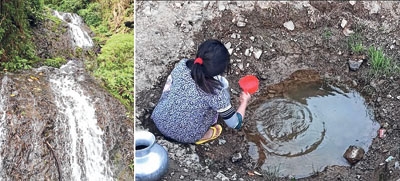Ukhrul's thirst : Climate change grip tightens on water supply
|

Addie Chiphang
NESTLED amidst the serene hills of Manipur, Ukhrul town stands as a testament to nature's beauty and bounty. With its coordinates marked at 25.12°N 94.37E and an elevation of 1662m (5453ft) above sea level, it boasts the distinction of being one of the highest hill stations in the region. For decades, life in this picturesque hill district unfolded with a rhythm dictated by its favorable climatic conditions–wet summers followed by chilly, dry winters.
However, the tranquility of Ukhrul's natural setting has been disrupted in recent years. An unnatural surge in heatwaves and erratic rainfall patterns has cast a shadow over the once idyllic landscape, leaving its residents grappling with the harsh realities of climate change.
One of the most pressing challenges facing the citizens of Ukhrul township is the scarcity of water. Not long ago, the town's water sources seemed abundant, with over 28 tangs (localities) boasting spring water ponds that catered to the needs of the populace. Yet, over the past five to six years, these natural reservoirs have witnessed a drastic depletion in volume. While human population growth may shoulder some of the blame, the underlying culprit lies in the widespread deforestation that has encroached upon Ukhrul's habitats and forest cover, exacerbating the effects of climate change.
Even the town's main water supply pipeline, fed by the perennial source of Shirui, has seen a dramatic decline in its output. In the late 90s and early 2000s, Shirui's waters flowed generously, supplying 8 to 9 lakh liters per day. Today, however, that figure has dwindled to a mere 3 to 4 lakh liters every two days–a far cry from the needs of Ukhrul's burgeoning population, which hovers between 70 to 80 thousand residents.
The Ukhrul Public Health Engineering Department (PHED) records reveal a stark reality: while there are 1200 registered water pipeline consumers and a handful of public hydrants, the daily demand for water stands at a staggering 27 lakh liters, far surpassing the meager supply of 3 to 4 lakh liters every two days. In response, the PHED has resorted to supplementing water distribution with tanker deliveries, albeit with limited success.
In Ukhrul Town, the cost of securing drinking water has soared to alarming levels, reflecting the severity of the issue. Currently, residents must shell out Rs 350 for 500 liters of potable water, while a larger quantity of 1000 liters commands a hefty sum of Rs 700. These exorbitant prices underscore the dire need for sustainable solutions to alleviate the burden on the populace.
Despite the town's abundant natural springs and ponds, with approximately 28 tangs or localities boasting 9 to 11 spring ponds each, the once plentiful water sources now offer little respite. Climate change-induced shifts in rainfall patterns and environmental degradation have led to a drastic reduction in water volume, exacerbating the plight of residents.
In the face of this crisis, enterprising individuals, primarily educated unemployed youths, have stepped in to fill the void by offering private drinking water supply services. Yet, these short-term solutions only scratch the surface of Ukhrul's water woes, failing to address the root causes of the town's predicament.
During my evaluation and monitoring of the water crisis, I had the opportunity to visit a spring pond where I encountered a woman named @Achui in her mid-50s. As I engaged her in conversation, she spoke to me calmly, her voice filled with concern, highlighting that in earlier times, water shortages were unheard of, and the younger generation never anticipated facing such scarcity.
She vividly described how women, in particular, would patiently await their turn to fetch water, sometimes until late into the night, and would even rise as early as 3 am just to secure a bucket of water, a concept unimaginable in the past. Moreover, she expressed sorrow over the significant climate changes witnessed over the last few decades, noting the increasing warmth with each passing year. With a sense of foreboding, she predicted that if this trend persists, future generations might find themselves in conflicts over access to even a single bucket of water.
To mitigate the looming threat of water scarcity, proactive measures must be taken. Planting suitable vegetation, including ornamental and fruit-bearing trees, tailored to Ukhrul's soil composition, offers a sustainable remedy. By safeguarding and replenishing the natural water cycle, these efforts can help preserve Ukhrul's lifeline – its water resources.
Furthermore, fostering awareness and fostering a culture of environmental stewardship is paramount. Random deforestation practices must be curbed, with a commitment to planting two to three trees for every one felled, ensuring the continuity of Ukhrul's ecosystem. Trees not only replenish water sources but also provide essential shade and habitat for humans, birds, and animals alike.
Ultimately, the fate of Ukhrul's water supply lies in the hands of its residents. As stewards of the land, it is incumbent upon us to nurture and protect our environment, ensuring a sustainable future where both human beings and nature can thrive in harmony. Only then can we weather the storms of climate change and safeguard Ukhrul's precious resource–water–for generations to come.
(Under Project Partnership)

